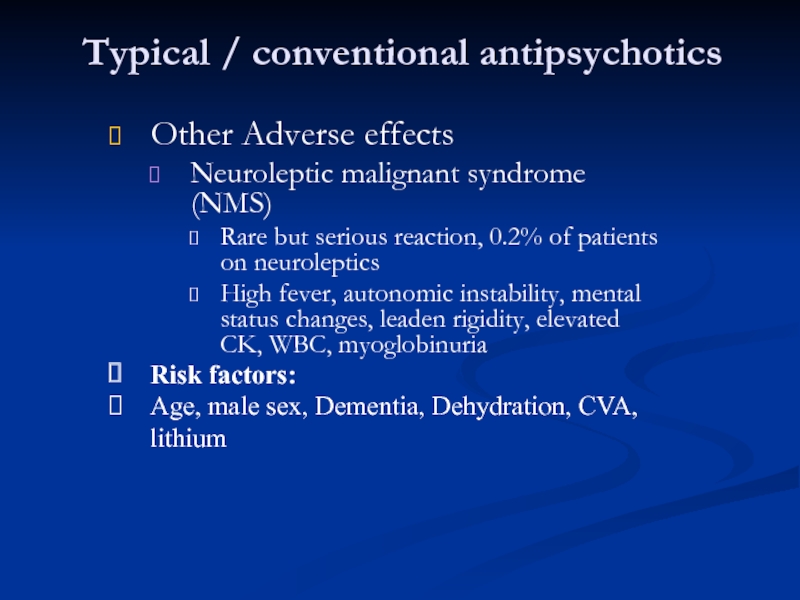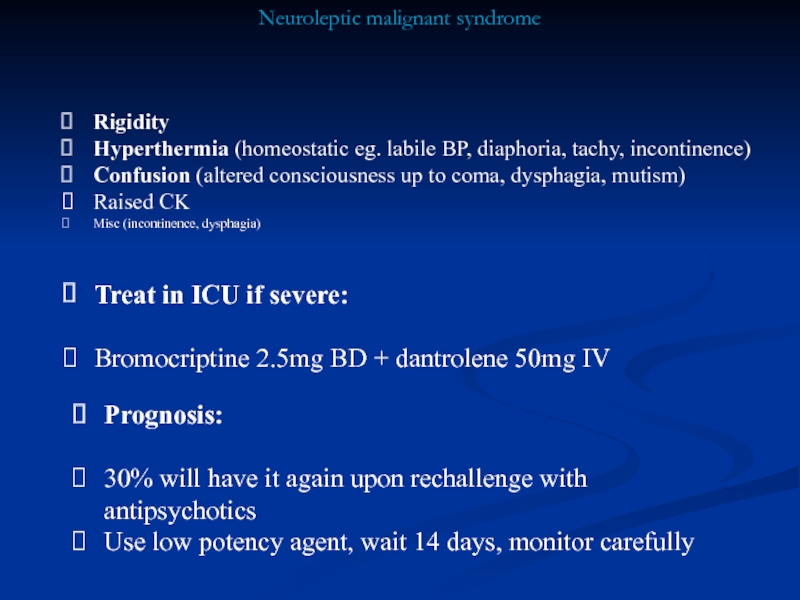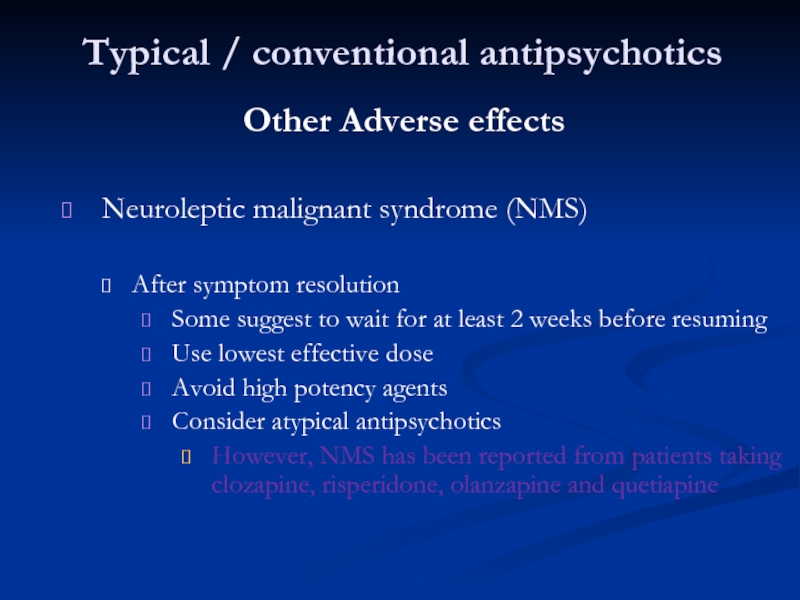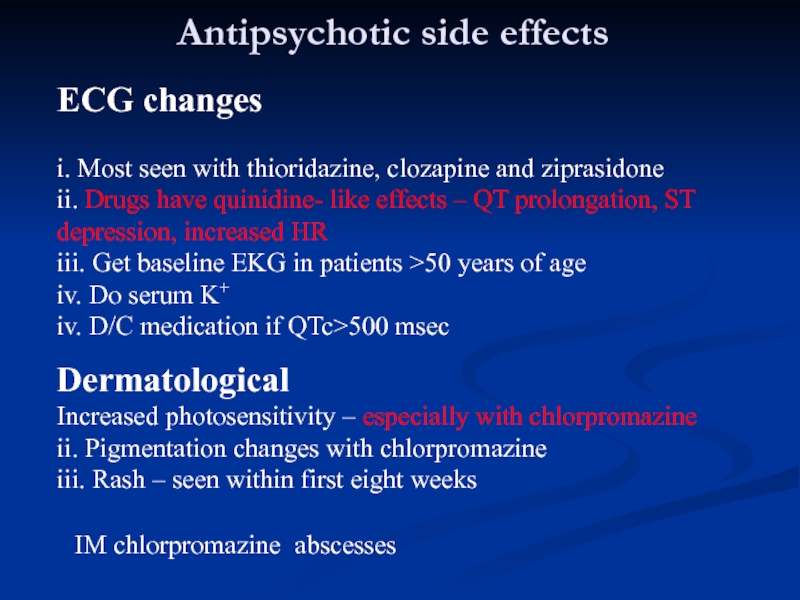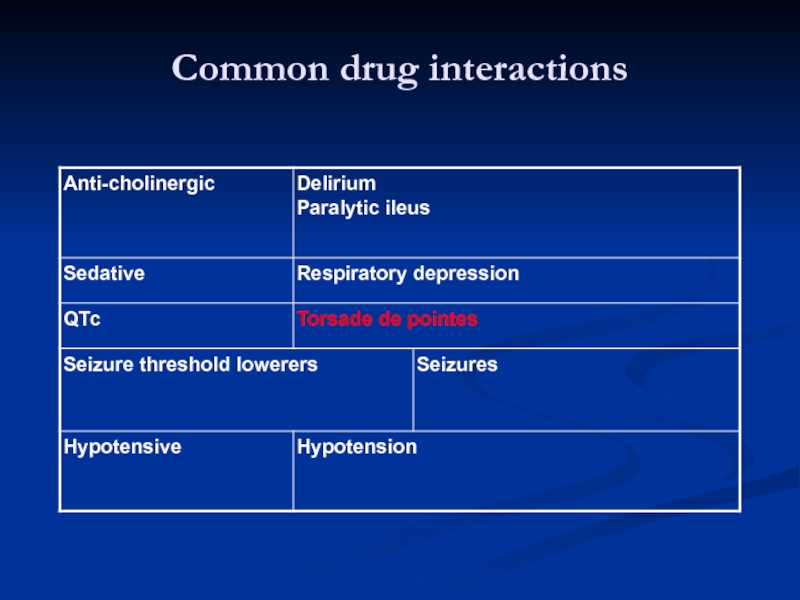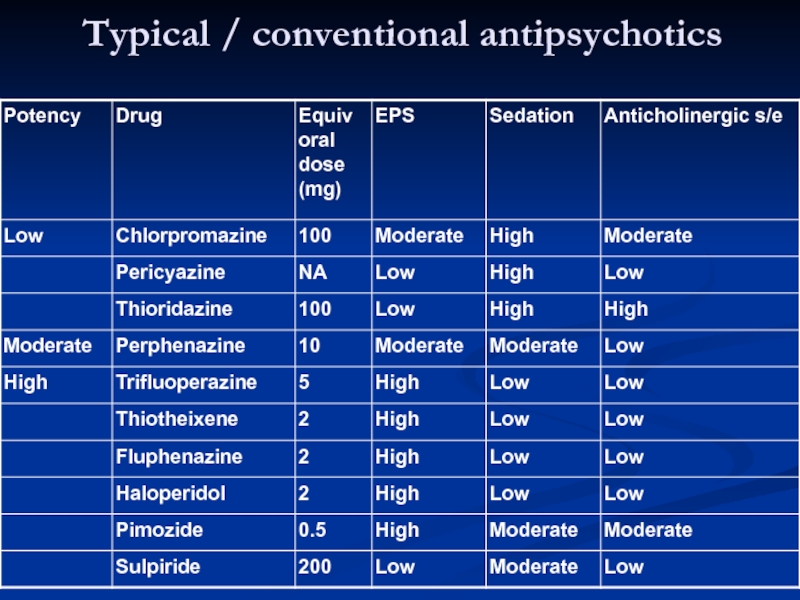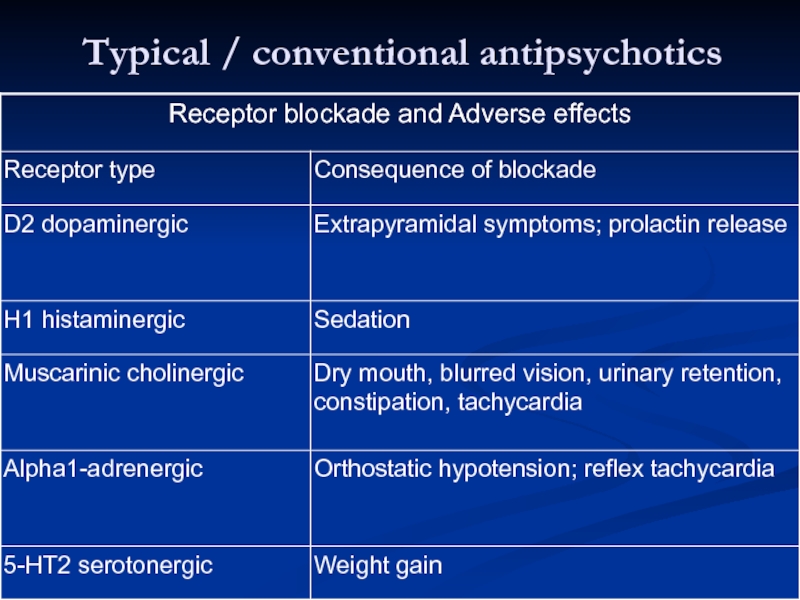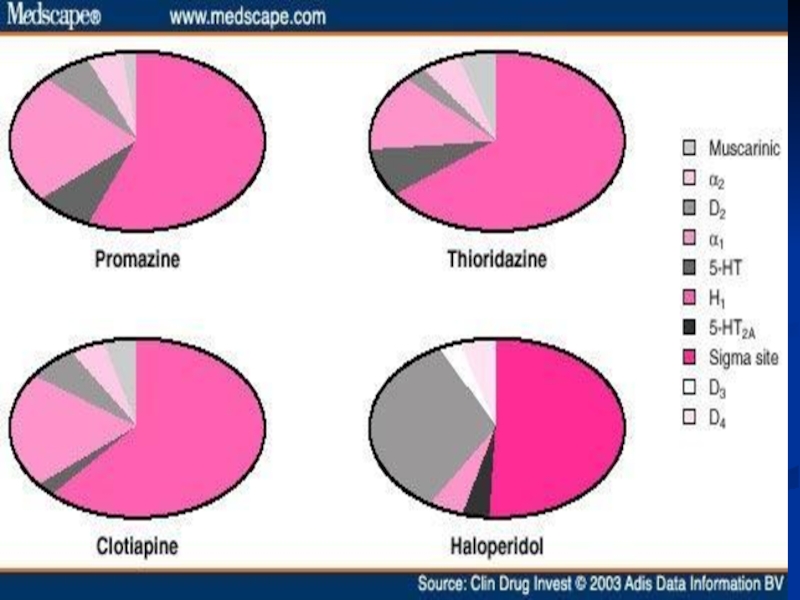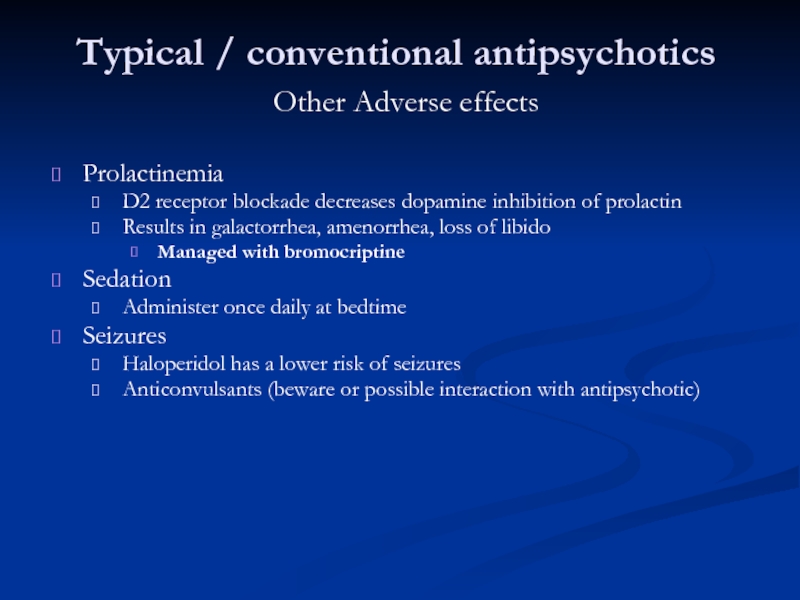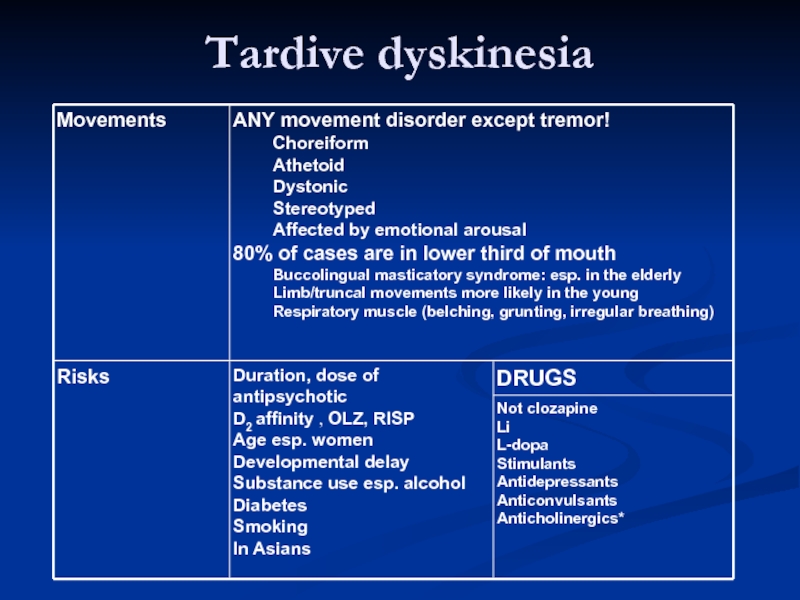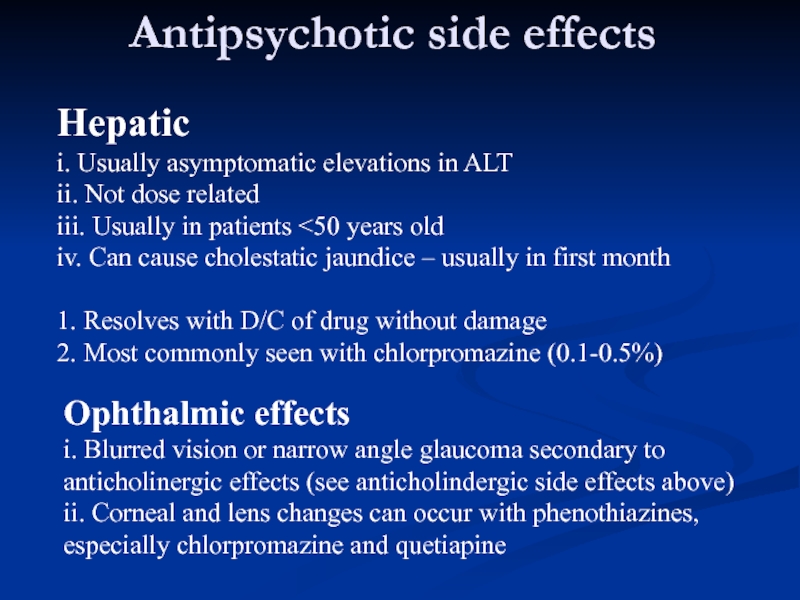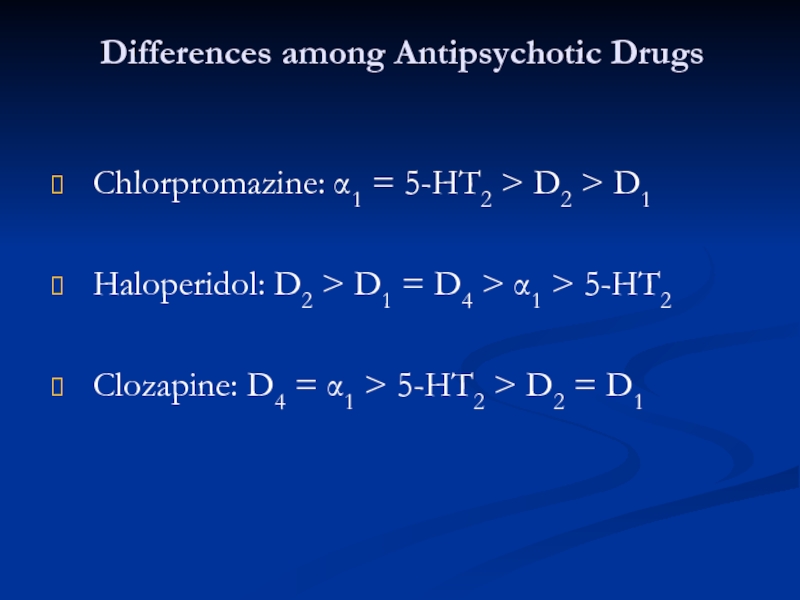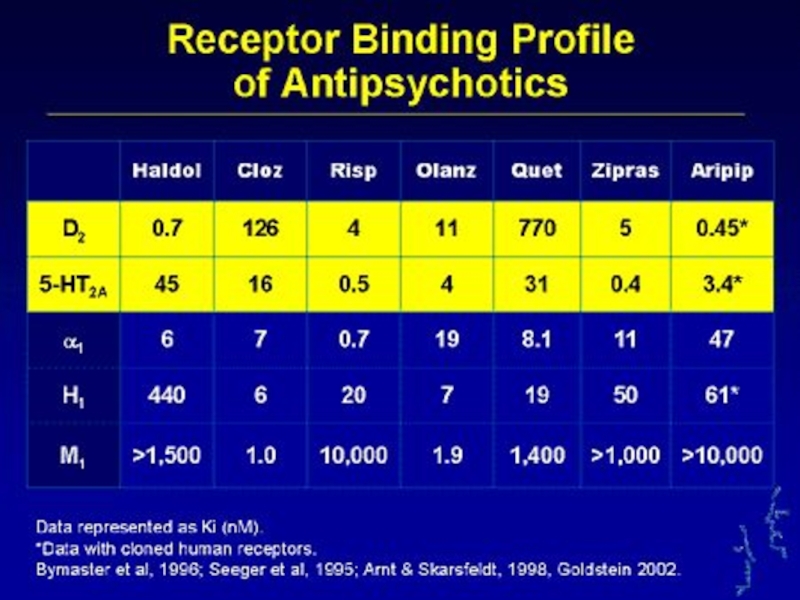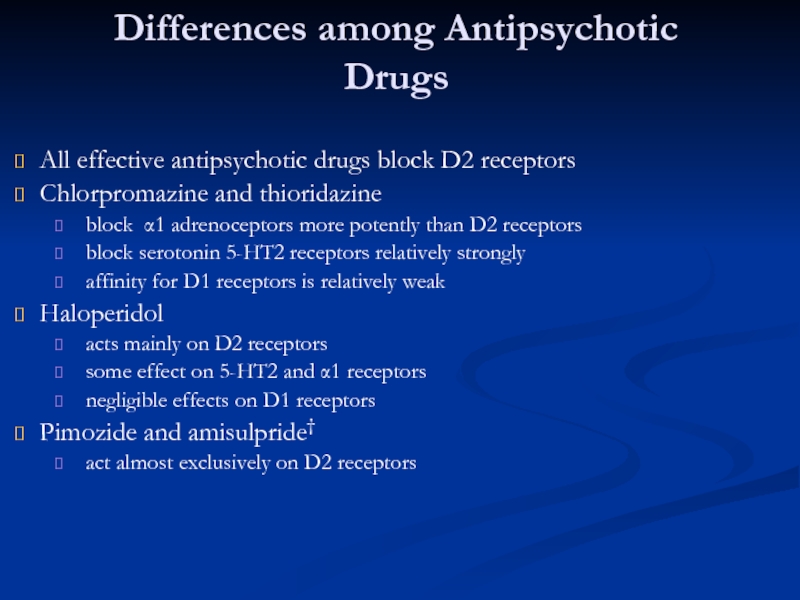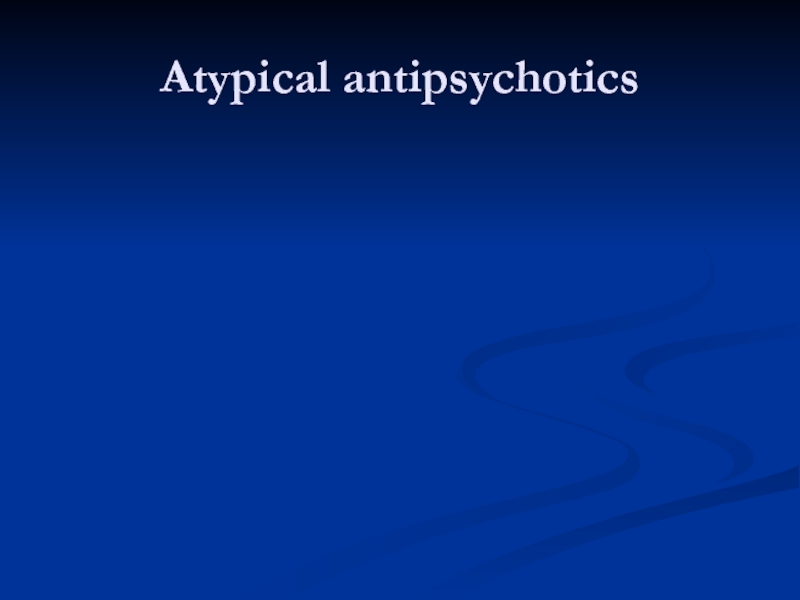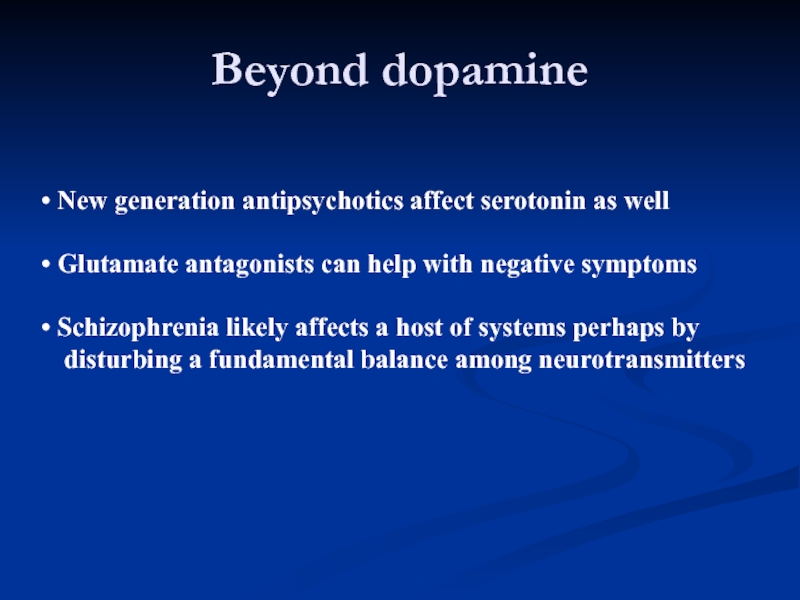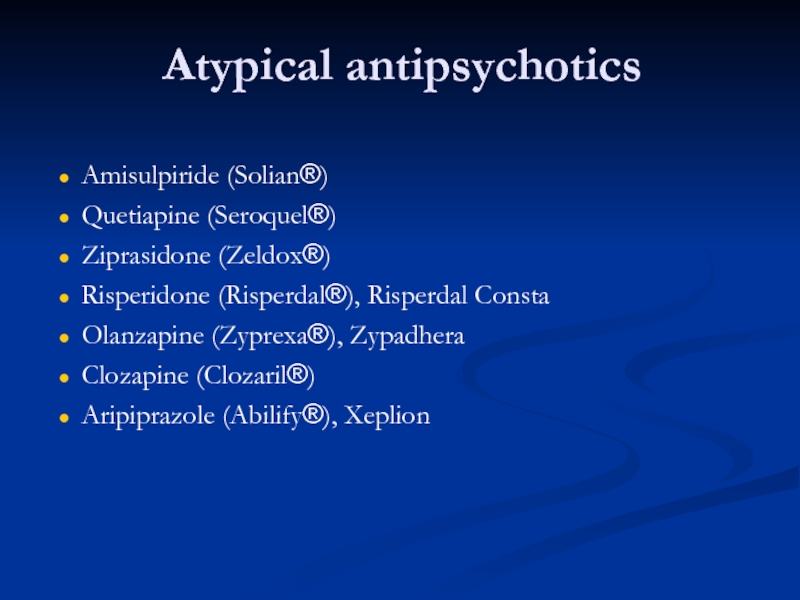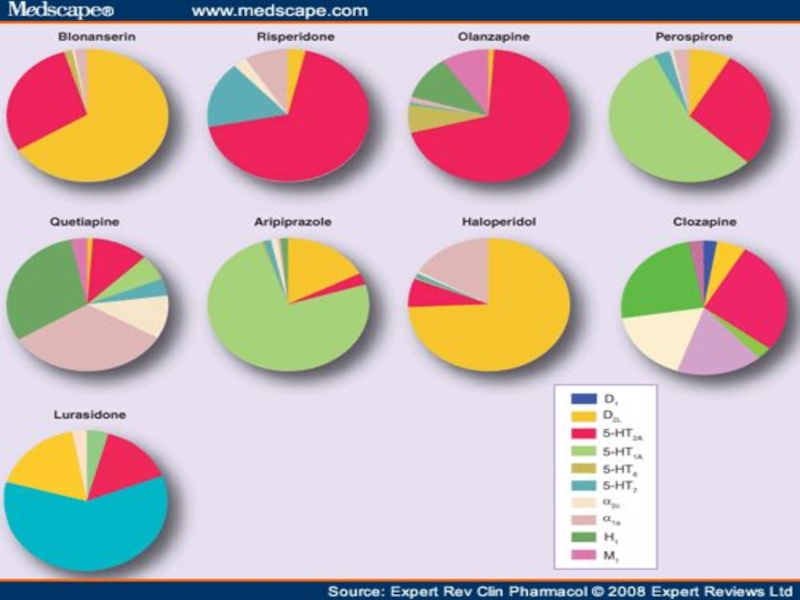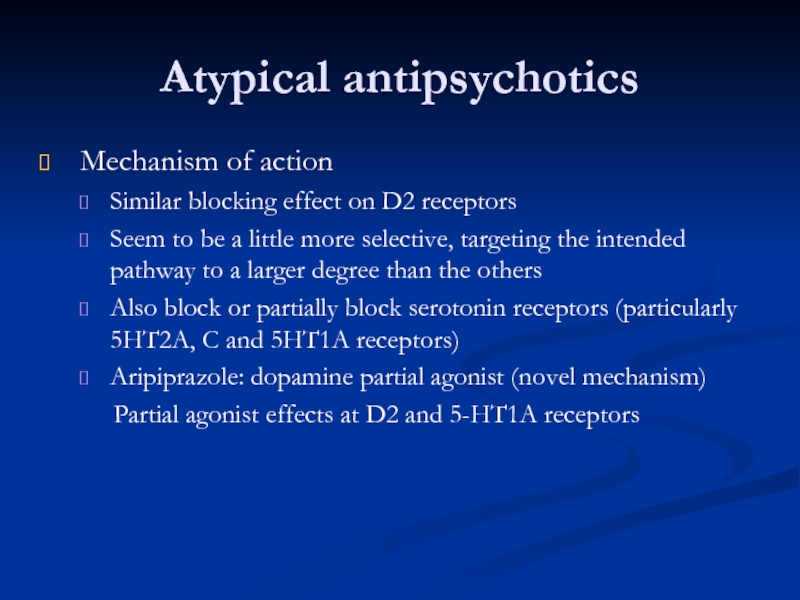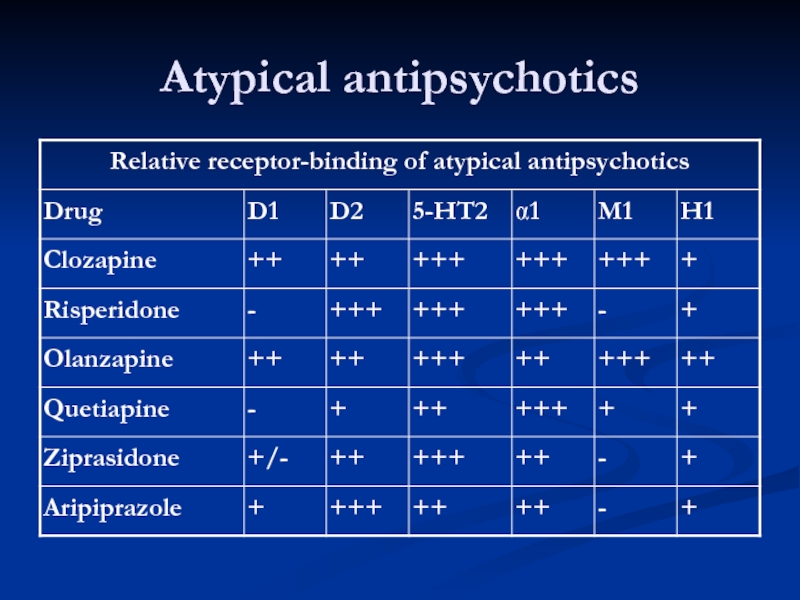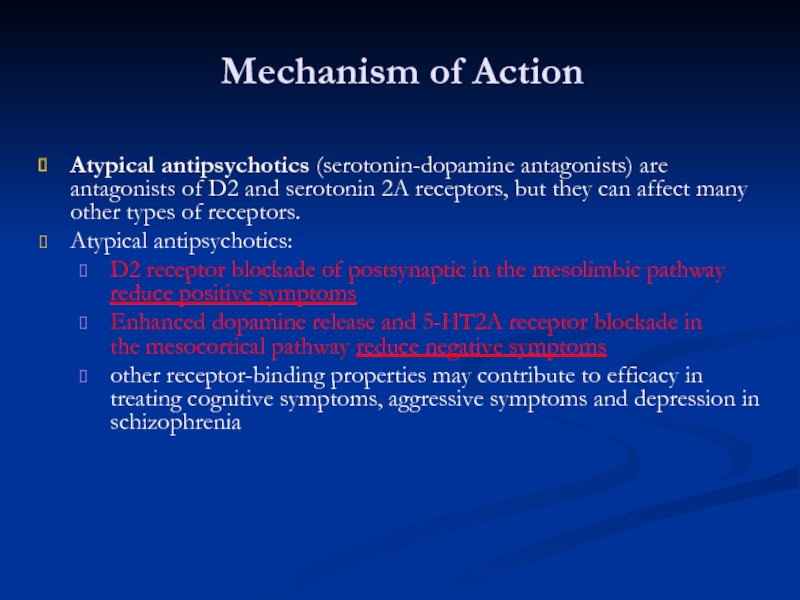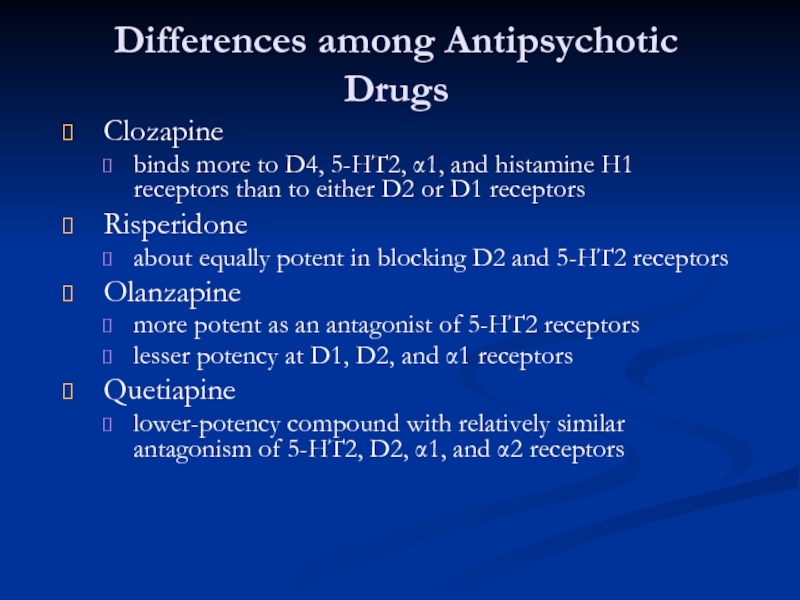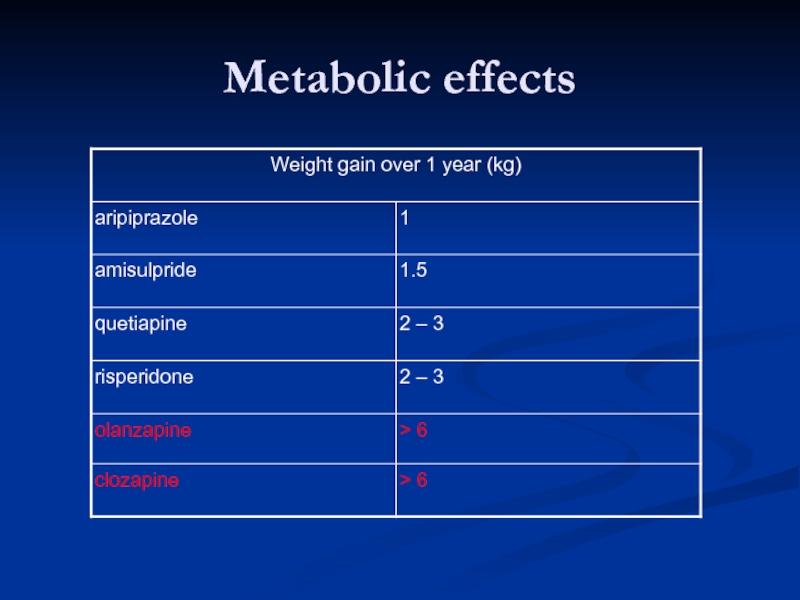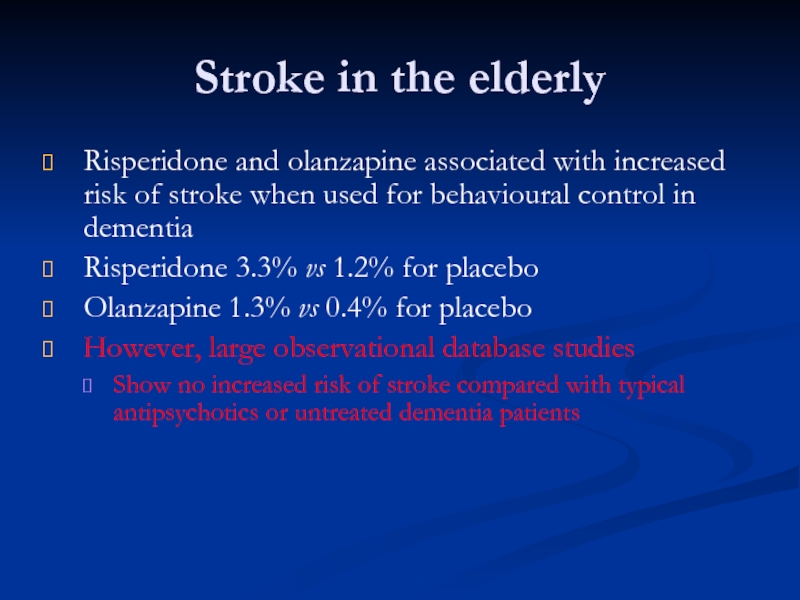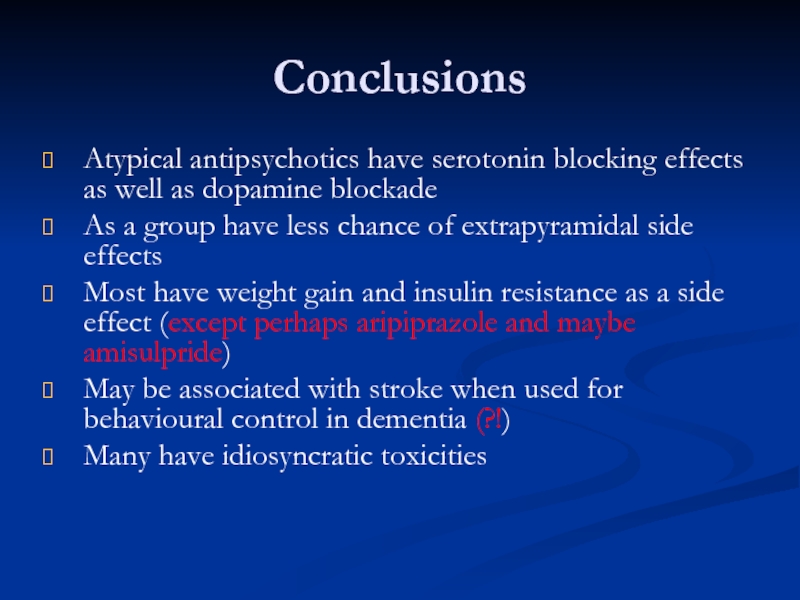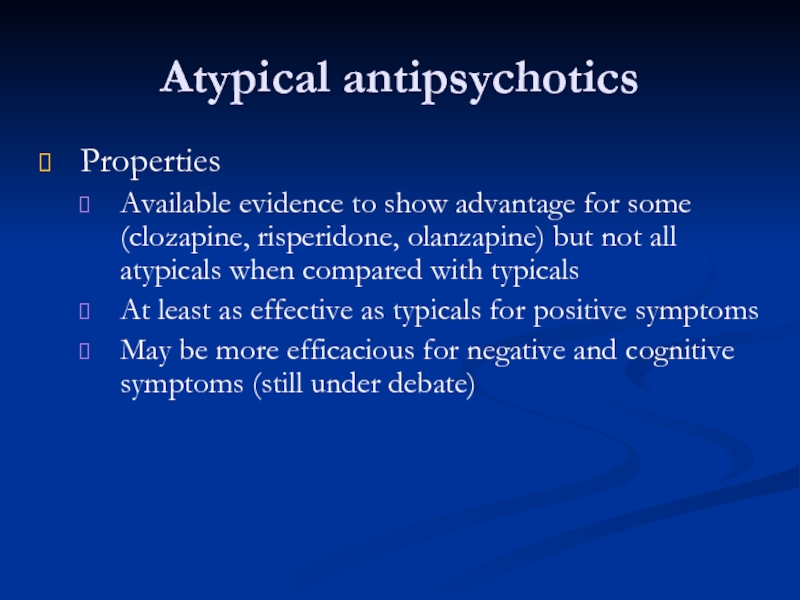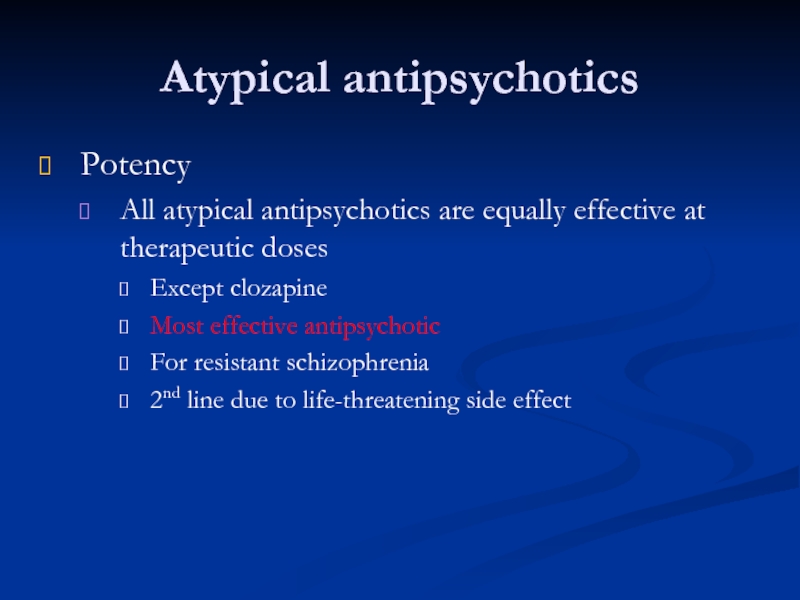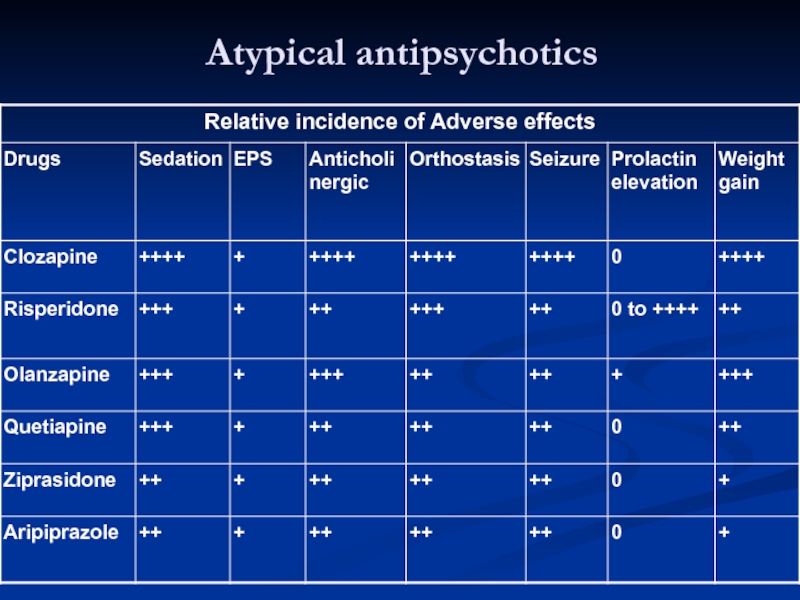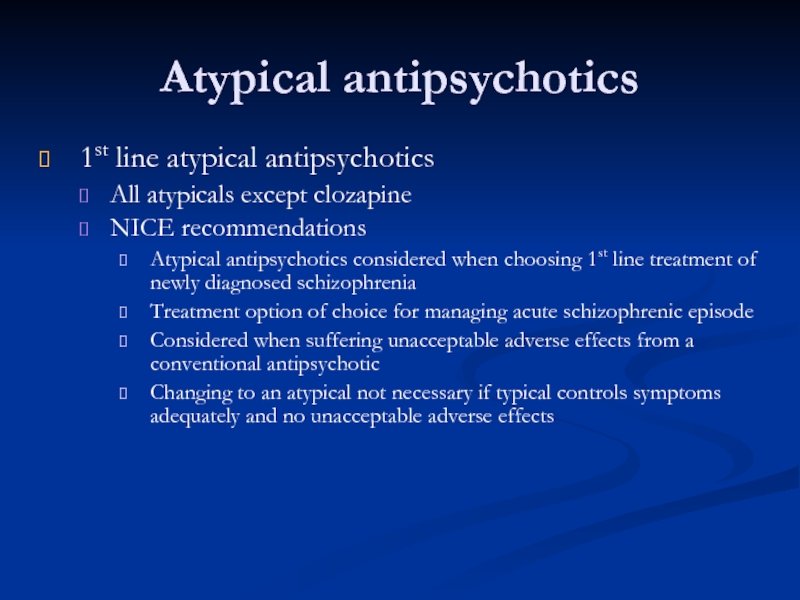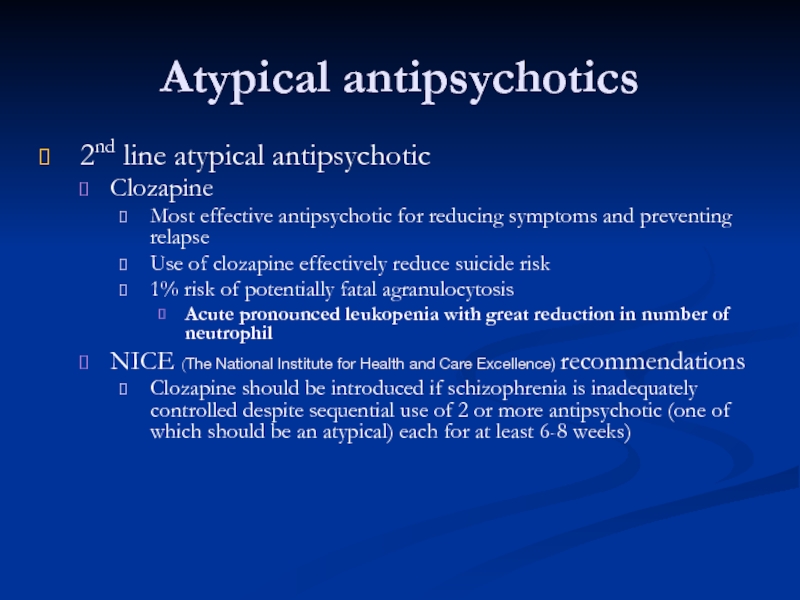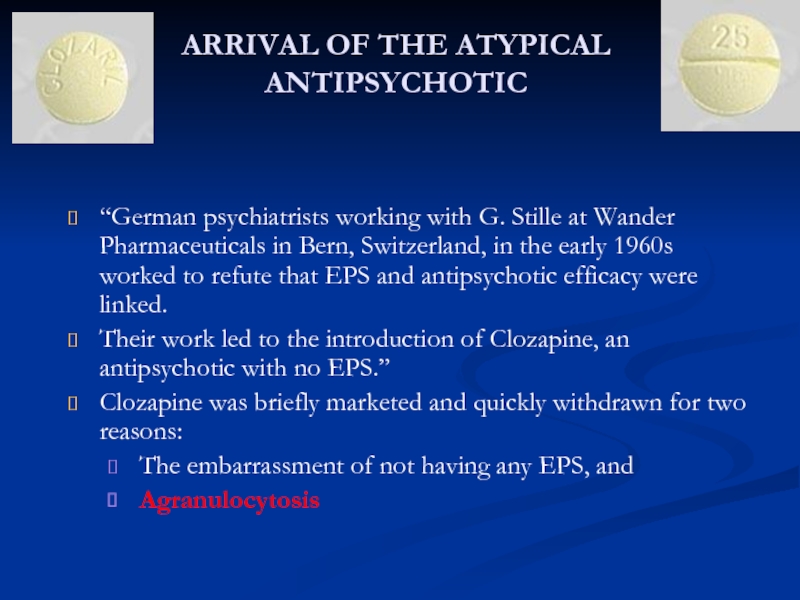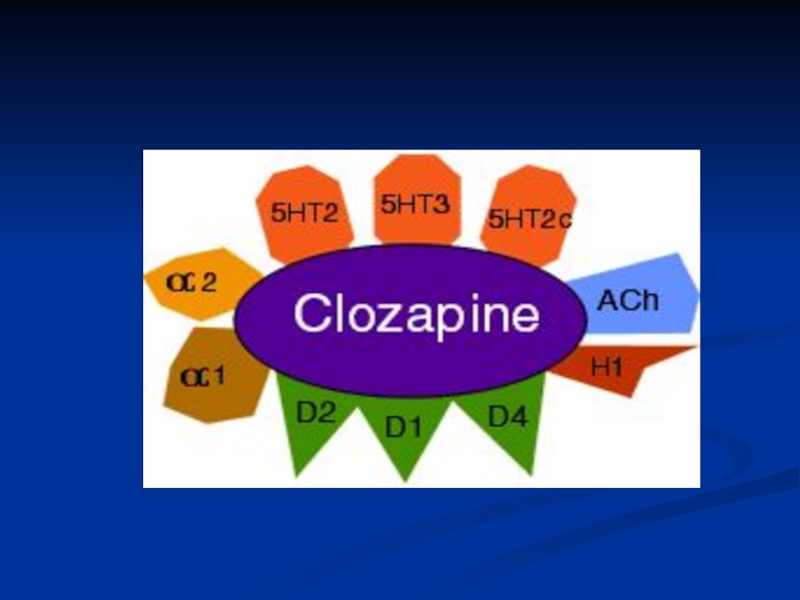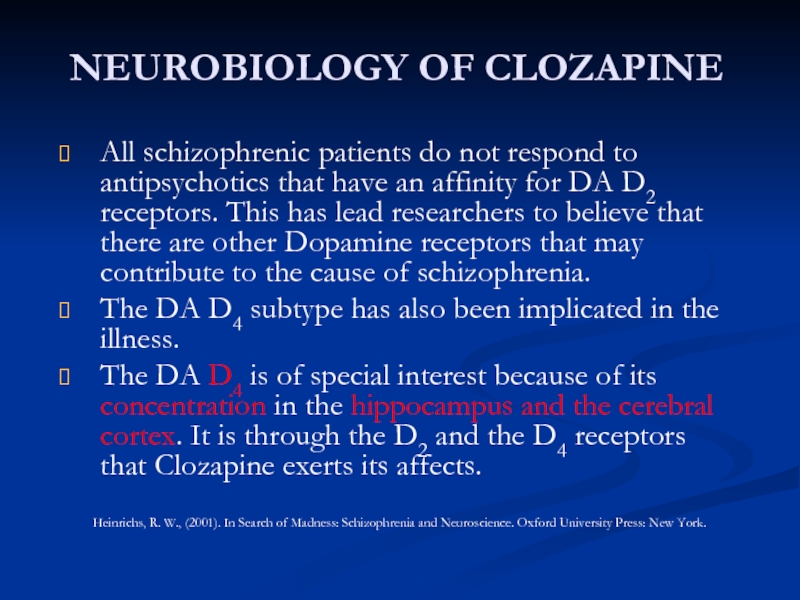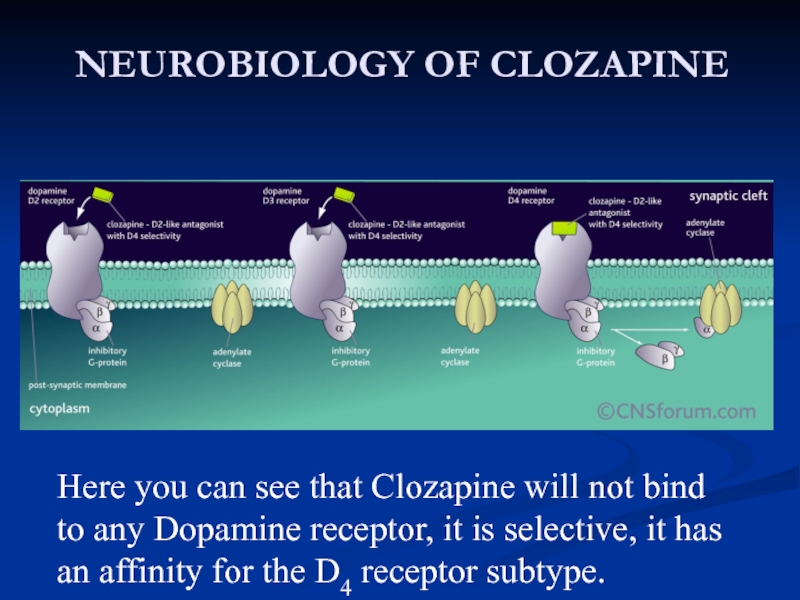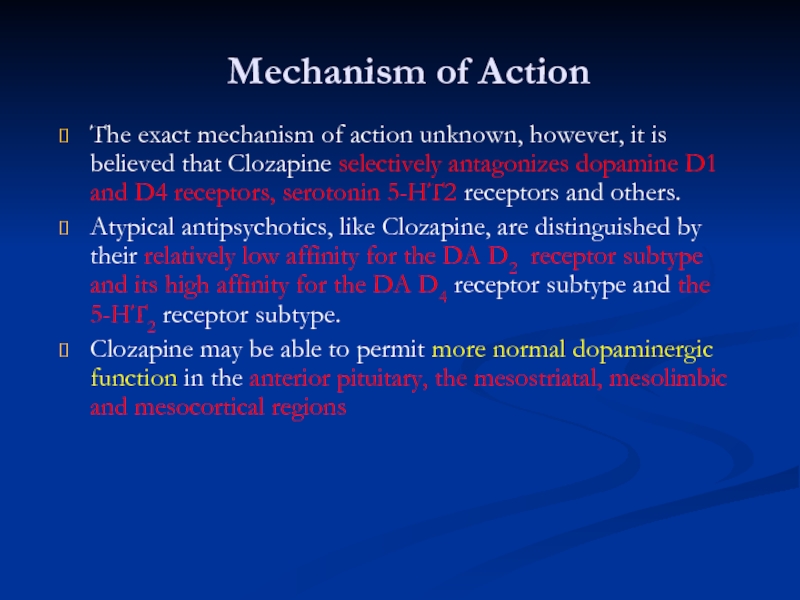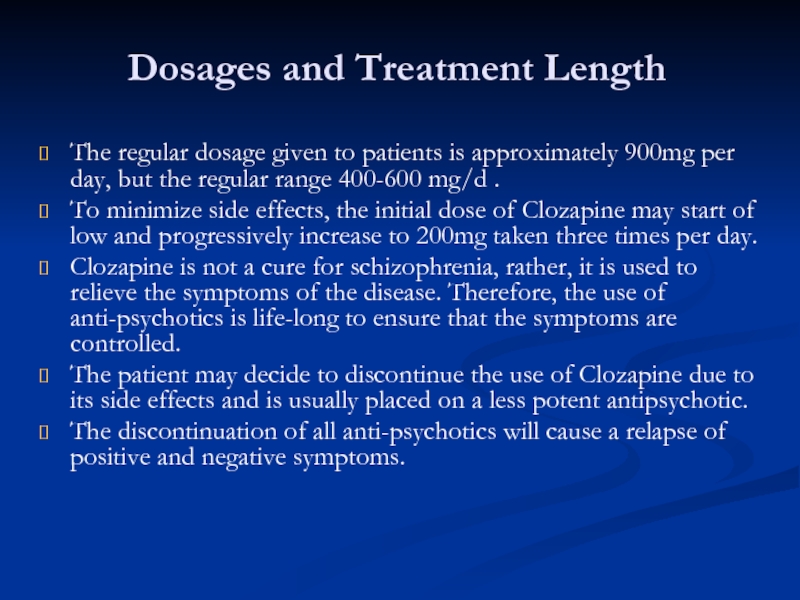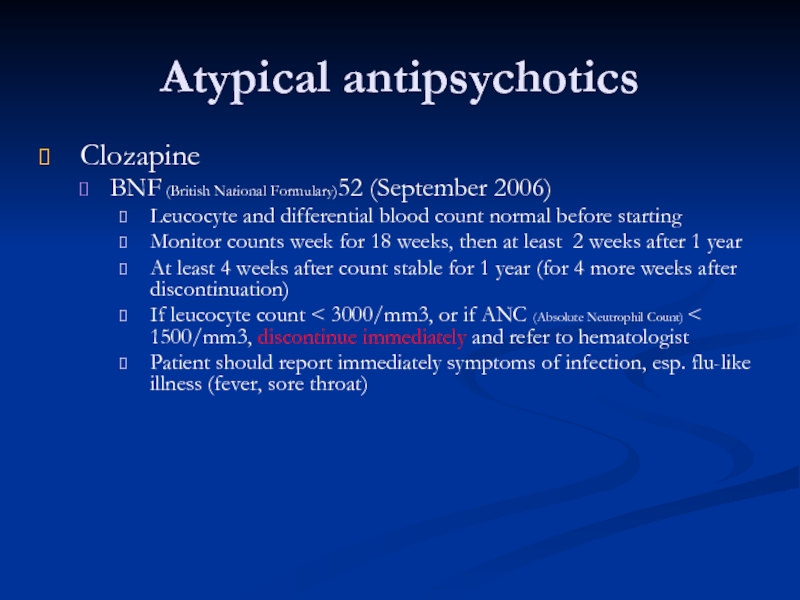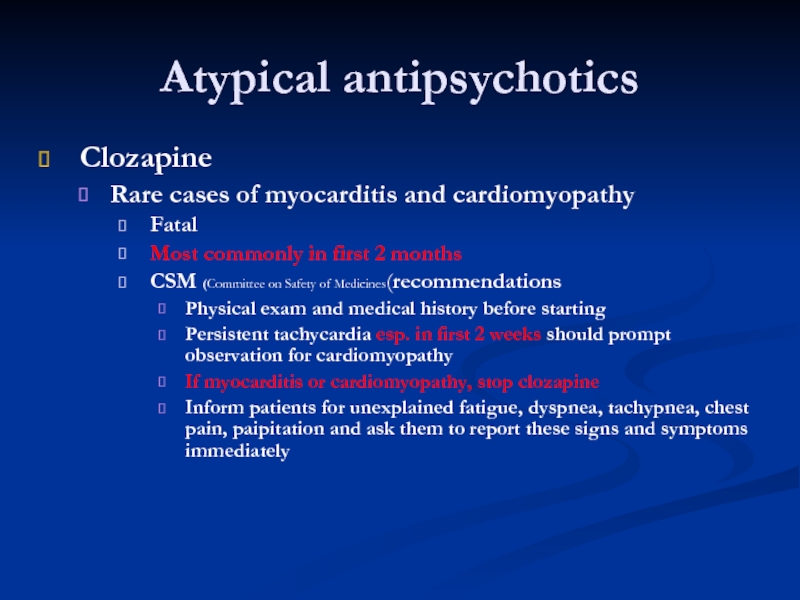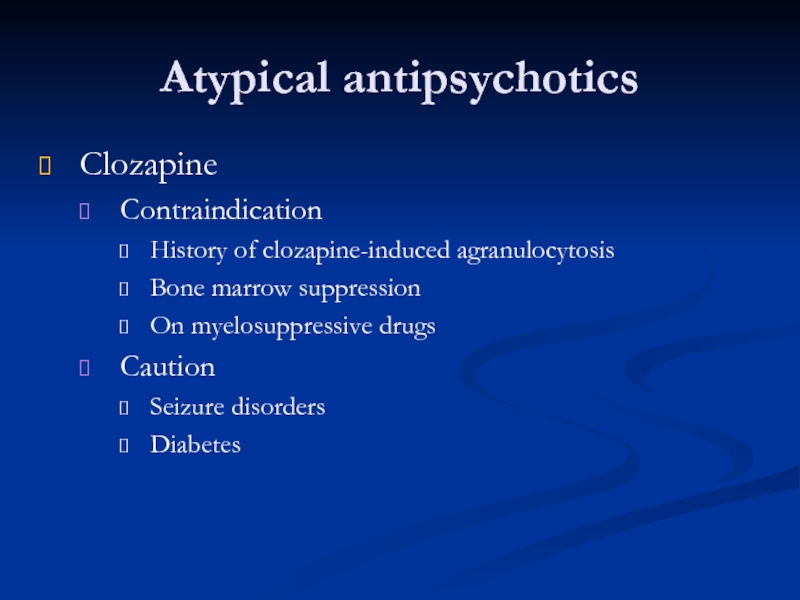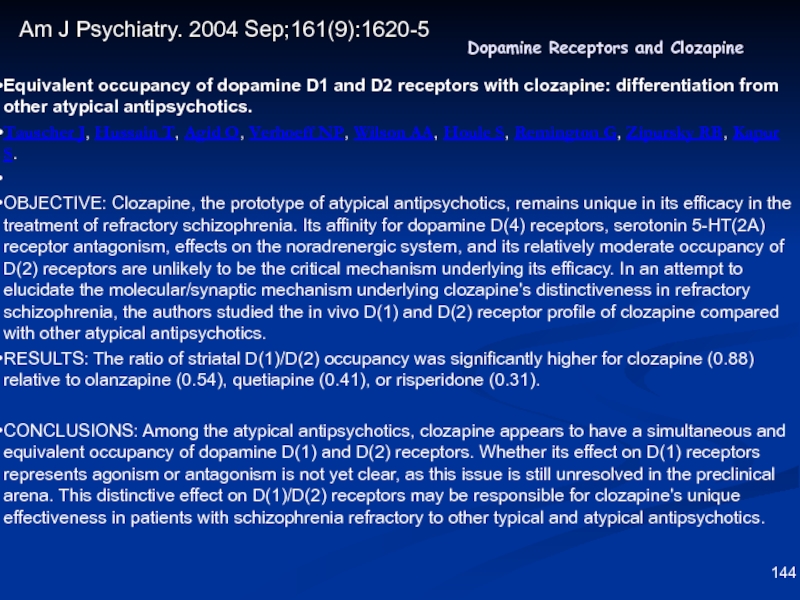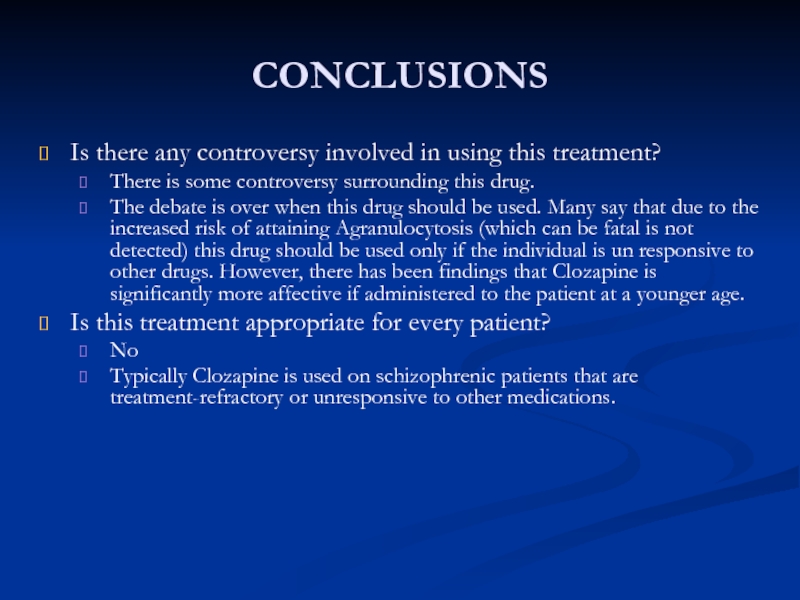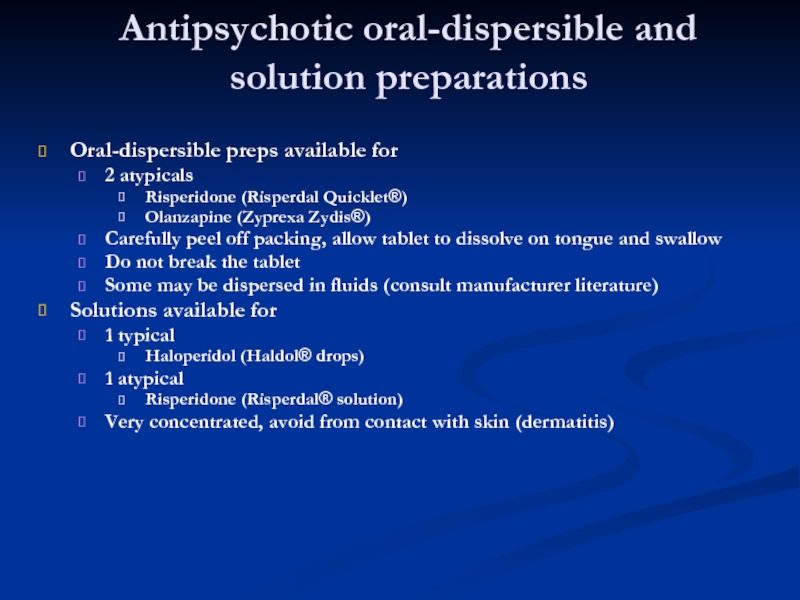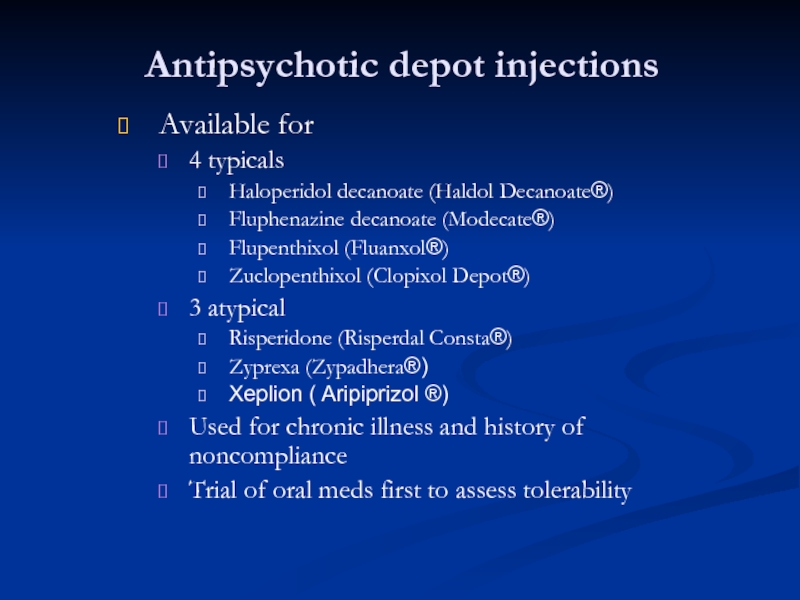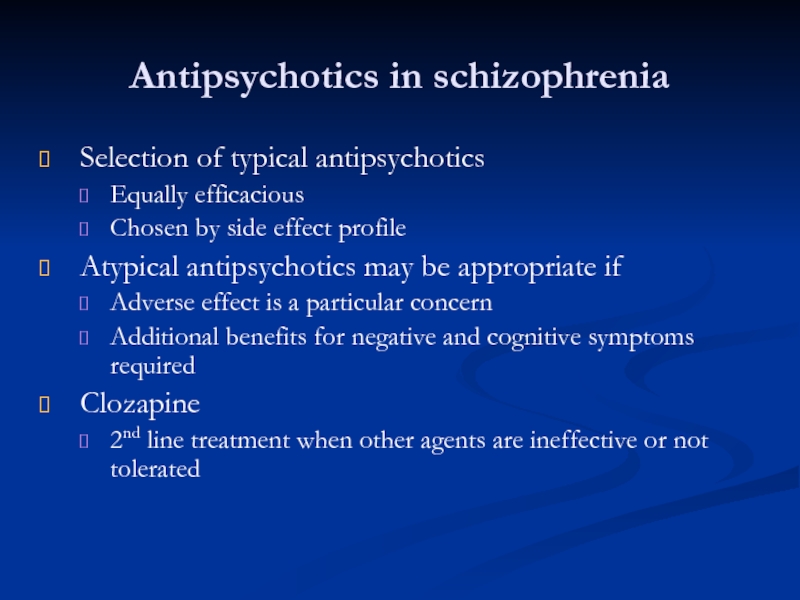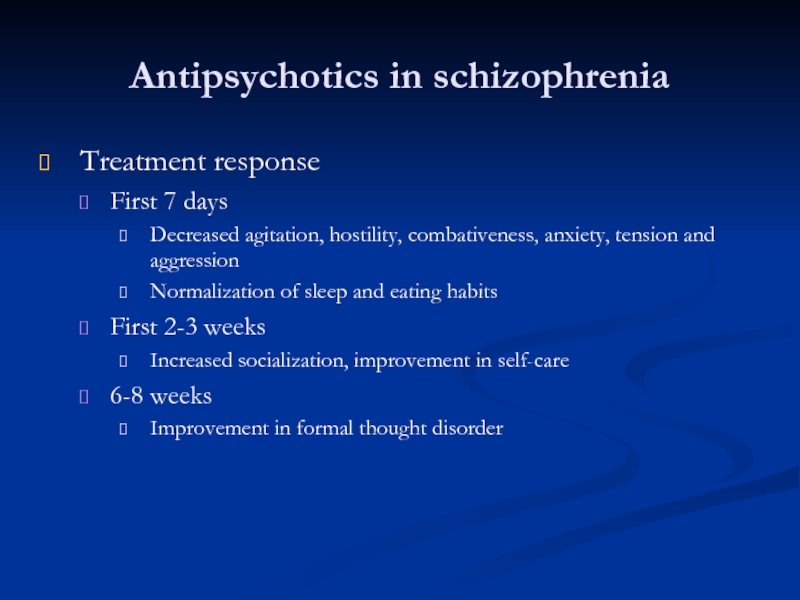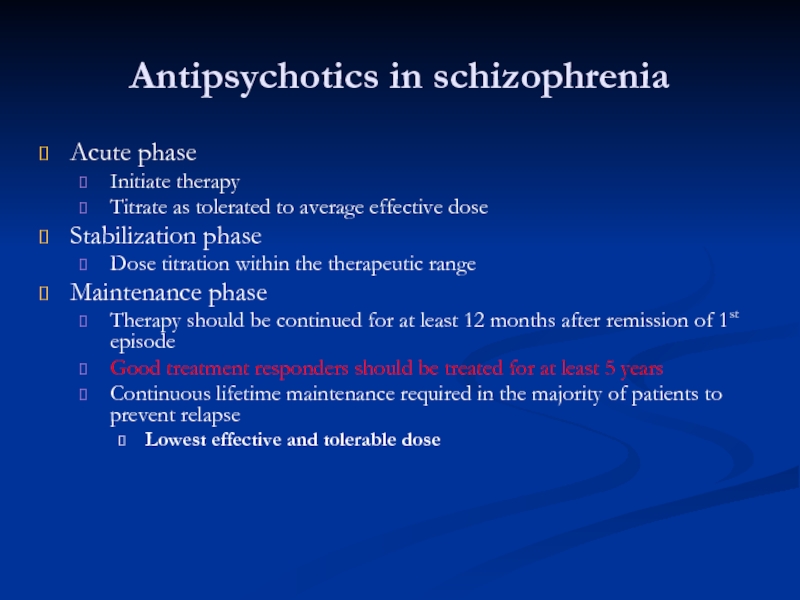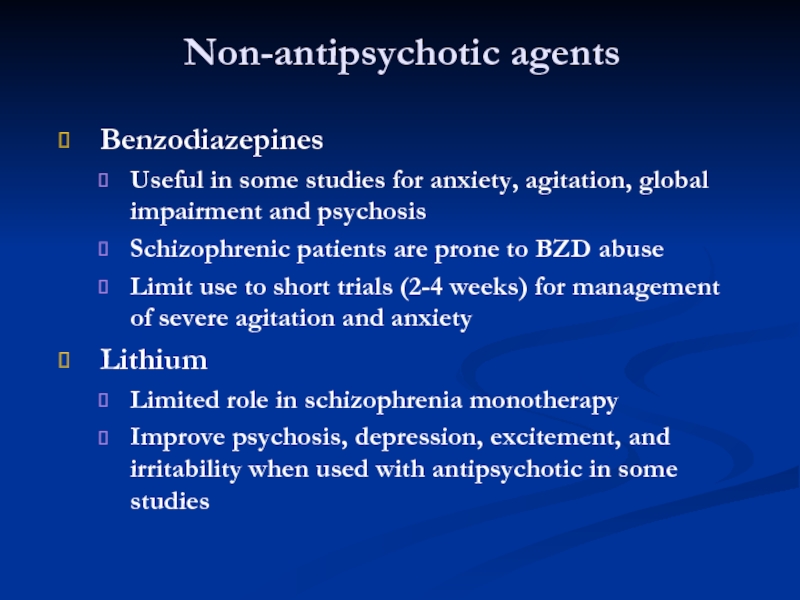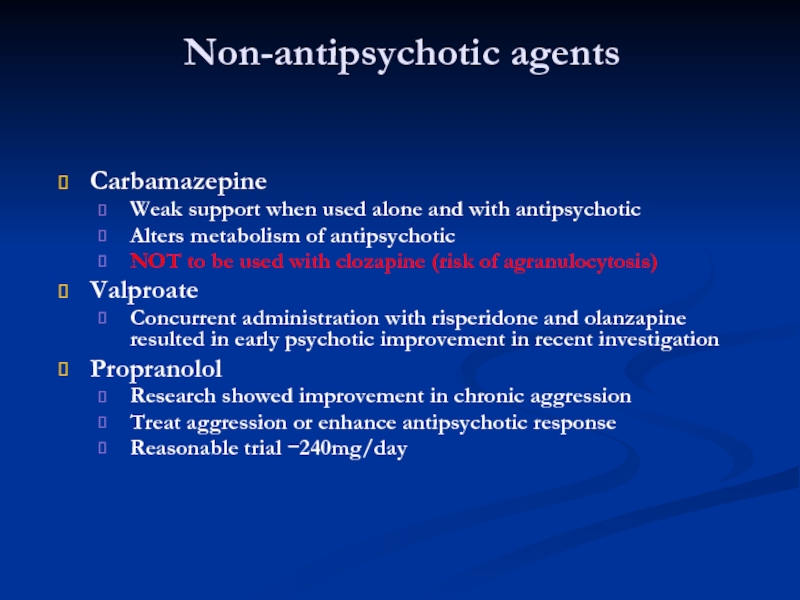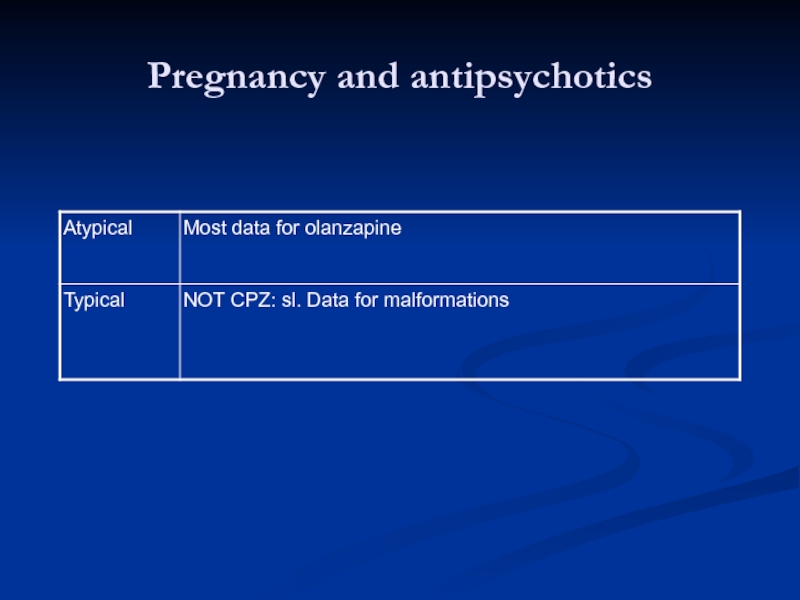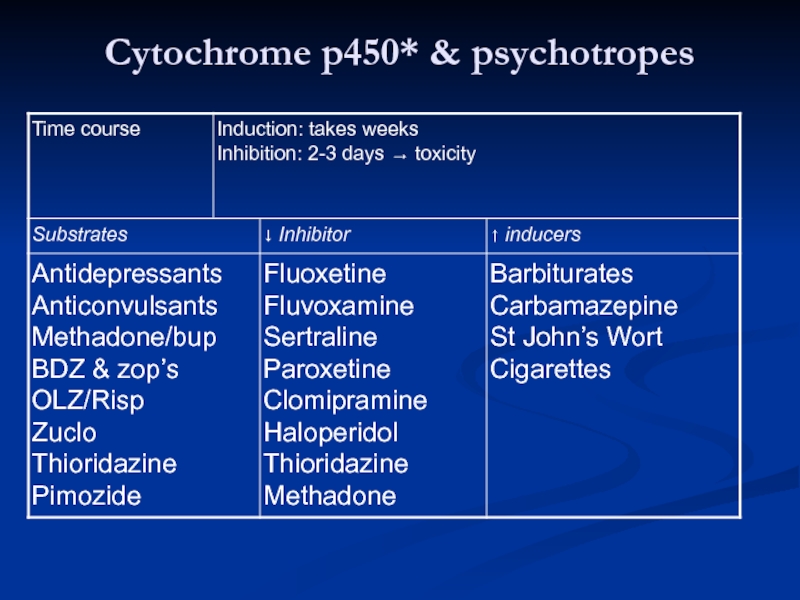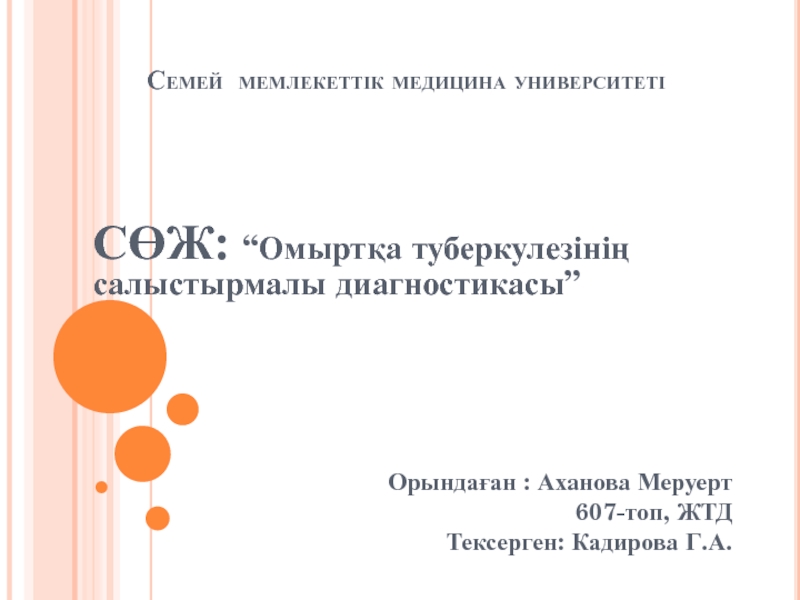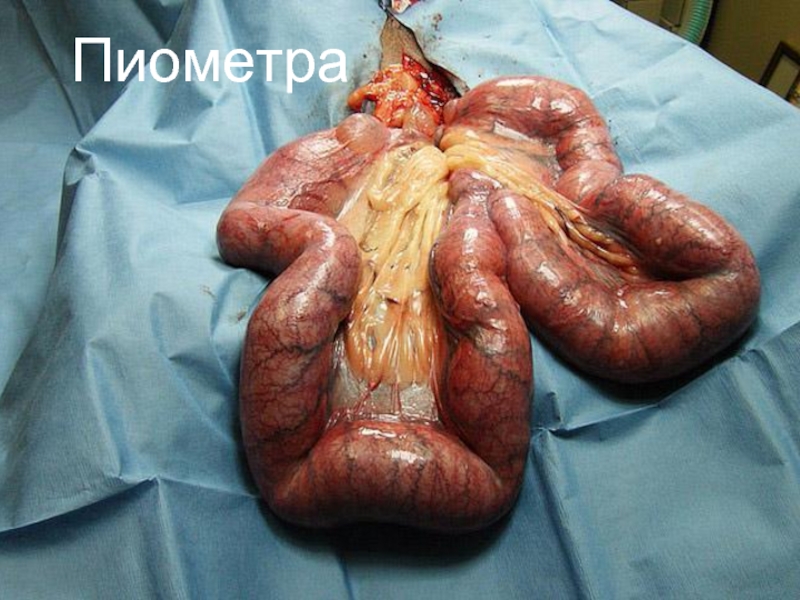- Главная
- Разное
- Дизайн
- Бизнес и предпринимательство
- Аналитика
- Образование
- Развлечения
- Красота и здоровье
- Финансы
- Государство
- Путешествия
- Спорт
- Недвижимость
- Армия
- Графика
- Культурология
- Еда и кулинария
- Лингвистика
- Английский язык
- Астрономия
- Алгебра
- Биология
- География
- Детские презентации
- Информатика
- История
- Литература
- Маркетинг
- Математика
- Медицина
- Менеджмент
- Музыка
- МХК
- Немецкий язык
- ОБЖ
- Обществознание
- Окружающий мир
- Педагогика
- Русский язык
- Технология
- Физика
- Философия
- Химия
- Шаблоны, картинки для презентаций
- Экология
- Экономика
- Юриспруденция
Typical / conventional antipsychotics презентация
Содержание
- 1. Typical / conventional antipsychotics
- 2. Neuroleptic malignant syndrome Rigidity Hyperthermia (homeostatic eg.
- 3. Typical / conventional antipsychotics Other Adverse effects
- 4. Antipsychotic side effects ECG changes i.
- 5. Common drug interactions
- 6. Typical / conventional antipsychotics
- 7. Typical / conventional antipsychotics
- 8. Typical / conventional antipsychotics
- 10. Typical / conventional antipsychotics Other Adverse effects
- 11. Tardive dyskinesia
- 12. Antipsychotic side effects Hepatic i. Usually asymptomatic
- 13. Differences among Antipsychotic Drugs Chlorpromazine: α1 =
- 15. Differences among Antipsychotic Drugs All effective
- 16. Atypical antipsychotics
- 17. Beyond dopamine New generation antipsychotics affect
- 18. Atypical antipsychotics Amisulpiride (Solian®) Quetiapine (Seroquel®) Ziprasidone
- 20. Atypical antipsychotics Mechanism of action Similar blocking
- 21. Atypical antipsychotics
- 22. Mechanism of Action Atypical antipsychotics (serotonin-dopamine antagonists)
- 23. Differences among Antipsychotic Drugs Clozapine binds
- 24. Atypical antipsychotics lower doses reduced side effects
- 25. Metabolic effects
- 26. Insulin resistance Prediabetes (impaired fasting glycaemia) has
- 27. Stroke in the elderly Risperidone and olanzapine
- 28. Conclusions Atypical antipsychotics have serotonin blocking effects
- 29. Atypical antipsychotics Properties Available evidence to show
- 30. Atypical antipsychotics Potency All atypical antipsychotics are
- 31. Atypical antipsychotics
- 32. Atypical antipsychotics 1st line atypical antipsychotics All
- 33. Atypical antipsychotics 2nd line atypical antipsychotic Clozapine
- 34. ARRIVAL OF THE ATYPICAL ANTIPSYCHOTIC “German psychiatrists
- 36. NEUROBIOLOGY OF CLOZAPINE All schizophrenic patients do
- 37. NEUROBIOLOGY OF CLOZAPINE Here you can see
- 38. Mechanism of Action The exact mechanism of
- 39. Dosages and Treatment Length The regular dosage
- 40. Atypical antipsychotics Clozapine BNF (British National Formulary)52
- 41. Atypical antipsychotics Clozapine Rare cases of myocarditis
- 42. Atypical antipsychotics Clozapine Contraindication History of clozapine-induced
- 43. 143 Equivalent occupancy of dopamine D1 and
- 44. 144 Equivalent occupancy of dopamine D1 and
- 45. CLOZAPINE Clozapine is considered by many as
- 46. CONCLUSIONS Is there any controversy involved in
- 47. Antipsychotic oral-dispersible and solution preparations Oral-dispersible preps
- 48. Antipsychotic depot injections Available for 4 typicals
- 49. Antipsychotics in schizophrenia Selection of typical antipsychotics
- 50. Antipsychotics in schizophrenia Treatment response First 7
- 52. Antipsychotics in schizophrenia Acute phase Initiate therapy
- 53. Non-antipsychotic agents Benzodiazepines Useful in some studies
- 54. Non-antipsychotic agents Carbamazepine Weak support when used
- 55. Pregnancy and antipsychotics
- 56. Cytochrome p450* & psychotropes
Слайд 1Typical / conventional antipsychotics
Other Adverse effects
Neuroleptic malignant syndrome (NMS)
Rare but serious
High fever, autonomic instability, mental status changes, leaden rigidity, elevated CK, WBC, myoglobinuria
Risk factors:
Age, male sex, Dementia, Dehydration, CVA, lithium
Слайд 2Neuroleptic malignant syndrome
Rigidity
Hyperthermia (homeostatic eg. labile BP, diaphoria, tachy, incontinence)
Confusion (altered
Raised CK
Misc (incontinence, dysphagia)
Treat in ICU if severe:
Bromocriptine 2.5mg BD + dantrolene 50mg IV
Prognosis:
30% will have it again upon rechallenge with antipsychotics
Use low potency agent, wait 14 days, monitor carefully
Слайд 3Typical / conventional antipsychotics
Other Adverse effects
Neuroleptic malignant syndrome (NMS)
After symptom resolution
Some
Use lowest effective dose
Avoid high potency agents
Consider atypical antipsychotics
However, NMS has been reported from patients taking clozapine, risperidone, olanzapine and quetiapine
Слайд 4Antipsychotic side effects
ECG changes
i. Most seen with thioridazine, clozapine and ziprasidone
ii.
depression, increased HR
iii. Get baseline EKG in patients >50 years of age
iv. Do serum K+
iv. D/C medication if QTc>500 msec
Dermatological
Increased photosensitivity – especially with chlorpromazine
ii. Pigmentation changes with chlorpromazine
iii. Rash – seen within first eight weeks
IM chlorpromazine abscesses
Слайд 10Typical / conventional antipsychotics
Other Adverse effects
Prolactinemia
D2 receptor blockade decreases dopamine inhibition
Results in galactorrhea, amenorrhea, loss of libido
Managed with bromocriptine
Sedation
Administer once daily at bedtime
Seizures
Haloperidol has a lower risk of seizures
Anticonvulsants (beware or possible interaction with antipsychotic)
Слайд 12Antipsychotic side effects
Hepatic
i. Usually asymptomatic elevations in ALT
ii. Not dose related
iii.
iv. Can cause cholestatic jaundice – usually in first month
1. Resolves with D/C of drug without damage
2. Most commonly seen with chlorpromazine (0.1-0.5%)
Ophthalmic effects
i. Blurred vision or narrow angle glaucoma secondary to
anticholinergic effects (see anticholindergic side effects above)
ii. Corneal and lens changes can occur with phenothiazines,
especially chlorpromazine and quetiapine
Слайд 13Differences among Antipsychotic Drugs
Chlorpromazine: α1 = 5-HT2 > D2 > D1
Haloperidol:
Clozapine: D4 = α1 > 5-HT2 > D2 = D1
Слайд 15Differences among Antipsychotic Drugs
All effective antipsychotic drugs block D2 receptors
Chlorpromazine and
block α1 adrenoceptors more potently than D2 receptors
block serotonin 5-HT2 receptors relatively strongly
affinity for D1 receptors is relatively weak
Haloperidol
acts mainly on D2 receptors
some effect on 5-HT2 and α1 receptors
negligible effects on D1 receptors
Pimozide and amisulpride†
act almost exclusively on D2 receptors
Слайд 17Beyond dopamine
New generation antipsychotics affect serotonin as well
Glutamate antagonists
Schizophrenia likely affects a host of systems perhaps by
disturbing a fundamental balance among neurotransmitters
Слайд 18Atypical antipsychotics
Amisulpiride (Solian®)
Quetiapine (Seroquel®)
Ziprasidone (Zeldox®)
Risperidone (Risperdal®), Risperdal Consta
Olanzapine (Zyprexa®), Zypadhera
Clozapine
Aripiprazole (Abilify®), Xeplion
Слайд 20Atypical antipsychotics
Mechanism of action
Similar blocking effect on D2 receptors
Seem to be
Also block or partially block serotonin receptors (particularly 5HT2A, C and 5HT1A receptors)
Aripiprazole: dopamine partial agonist (novel mechanism)
Partial agonist effects at D2 and 5-HT1A receptors
Слайд 22Mechanism of Action
Atypical antipsychotics (serotonin-dopamine antagonists) are antagonists of D2 and
Atypical antipsychotics:
D2 receptor blockade of postsynaptic in the mesolimbic pathway reduce positive symptoms
Enhanced dopamine release and 5-HT2A receptor blockade in the mesocortical pathway reduce negative symptoms
other receptor-binding properties may contribute to efficacy in treating cognitive symptoms, aggressive symptoms and depression in schizophrenia
Слайд 23Differences among Antipsychotic Drugs
Clozapine
binds more to D4, 5-HT2, α1, and
Risperidone
about equally potent in blocking D2 and 5-HT2 receptors
Olanzapine
more potent as an antagonist of 5-HT2 receptors
lesser potency at D1, D2, and α1 receptors
Quetiapine
lower-potency compound with relatively similar antagonism of 5-HT2, D2, α1, and α2 receptors
Слайд 24Atypical antipsychotics
lower doses
reduced side effects
more effective (especially negative symptoms)
better compliance
Evidence?
trials have
trials have tended to show equivalent efficacy and better side effect profiles with newer drugs
head to head trials claimed superiority of olanzapine over risperidone (but company sponsored and controversial); some “parallel publications”
Costs
Much higher with new drugs (10-40 times higher)
Слайд 26Insulin resistance
Prediabetes (impaired fasting glycaemia) has ~ 10% chance / year
Prediabetes plus olanzapine has a 6-fold increased risk of conversion
If olanzapine is stopped 70% will revert back to prediabetes
Слайд 27Stroke in the elderly
Risperidone and olanzapine associated with increased risk of
Risperidone 3.3% vs 1.2% for placebo
Olanzapine 1.3% vs 0.4% for placebo
However, large observational database studies
Show no increased risk of stroke compared with typical antipsychotics or untreated dementia patients
Слайд 28Conclusions
Atypical antipsychotics have serotonin blocking effects as well as dopamine blockade
As
Most have weight gain and insulin resistance as a side effect (except perhaps aripiprazole and maybe amisulpride)
May be associated with stroke when used for behavioural control in dementia (?!)
Many have idiosyncratic toxicities
Слайд 29Atypical antipsychotics
Properties
Available evidence to show advantage for some (clozapine, risperidone, olanzapine)
At least as effective as typicals for positive symptoms
May be more efficacious for negative and cognitive symptoms (still under debate)
Слайд 30Atypical antipsychotics
Potency
All atypical antipsychotics are equally effective at therapeutic doses
Except clozapine
Most
For resistant schizophrenia
2nd line due to life-threatening side effect
Слайд 32Atypical antipsychotics
1st line atypical antipsychotics
All atypicals except clozapine
NICE recommendations
Atypical antipsychotics considered
Treatment option of choice for managing acute schizophrenic episode
Considered when suffering unacceptable adverse effects from a conventional antipsychotic
Changing to an atypical not necessary if typical controls symptoms adequately and no unacceptable adverse effects
Слайд 33Atypical antipsychotics
2nd line atypical antipsychotic
Clozapine
Most effective antipsychotic for reducing symptoms and
Use of clozapine effectively reduce suicide risk
1% risk of potentially fatal agranulocytosis
Acute pronounced leukopenia with great reduction in number of neutrophil
NICE (The National Institute for Health and Care Excellence) recommendations
Clozapine should be introduced if schizophrenia is inadequately controlled despite sequential use of 2 or more antipsychotic (one of which should be an atypical) each for at least 6-8 weeks)
Слайд 34ARRIVAL OF THE ATYPICAL ANTIPSYCHOTIC
“German psychiatrists working with G. Stille at
Their work led to the introduction of Clozapine, an antipsychotic with no EPS.”
Clozapine was briefly marketed and quickly withdrawn for two reasons:
The embarrassment of not having any EPS, and
Agranulocytosis
Слайд 36NEUROBIOLOGY OF CLOZAPINE
All schizophrenic patients do not respond to antipsychotics that
The DA D4 subtype has also been implicated in the illness.
The DA D4 is of special interest because of its concentration in the hippocampus and the cerebral cortex. It is through the D2 and the D4 receptors that Clozapine exerts its affects.
Heinrichs, R. W., (2001). In Search of Madness: Schizophrenia and Neuroscience. Oxford University Press: New York.
Слайд 37NEUROBIOLOGY OF CLOZAPINE
Here you can see that Clozapine will not bind
Слайд 38Mechanism of Action
The exact mechanism of action unknown, however, it is
Atypical antipsychotics, like Clozapine, are distinguished by their relatively low affinity for the DA D2 receptor subtype and its high affinity for the DA D4 receptor subtype and the 5-HT2 receptor subtype.
Clozapine may be able to permit more normal dopaminergic function in the anterior pituitary, the mesostriatal, mesolimbic and mesocortical regions
Слайд 39Dosages and Treatment Length
The regular dosage given to patients is approximately
To minimize side effects, the initial dose of Clozapine may start of low and progressively increase to 200mg taken three times per day.
Clozapine is not a cure for schizophrenia, rather, it is used to relieve the symptoms of the disease. Therefore, the use of anti-psychotics is life-long to ensure that the symptoms are controlled.
The patient may decide to discontinue the use of Clozapine due to its side effects and is usually placed on a less potent antipsychotic.
The discontinuation of all anti-psychotics will cause a relapse of positive and negative symptoms.
Слайд 40Atypical antipsychotics
Clozapine
BNF (British National Formulary)52 (September 2006)
Leucocyte and differential blood count
Monitor counts week for 18 weeks, then at least 2 weeks after 1 year
At least 4 weeks after count stable for 1 year (for 4 more weeks after discontinuation)
If leucocyte count < 3000/mm3, or if ANC (Absolute Neutrophil Count) < 1500/mm3, discontinue immediately and refer to hematologist
Patient should report immediately symptoms of infection, esp. flu-like illness (fever, sore throat)
Слайд 41Atypical antipsychotics
Clozapine
Rare cases of myocarditis and cardiomyopathy
Fatal
Most commonly in first 2
CSM (Committee on Safety of Medicines(recommendations
Physical exam and medical history before starting
Persistent tachycardia esp. in first 2 weeks should prompt observation for cardiomyopathy
If myocarditis or cardiomyopathy, stop clozapine
Inform patients for unexplained fatigue, dyspnea, tachypnea, chest pain, paipitation and ask them to report these signs and symptoms immediately
Слайд 42Atypical antipsychotics
Clozapine
Contraindication
History of clozapine-induced agranulocytosis
Bone marrow suppression
On myelosuppressive drugs
Caution
Seizure disorders
Diabetes
Слайд 43143
Equivalent occupancy of dopamine D1 and D2 receptors with clozapine: differentiation
Tauscher J, Hussain T, Agid O, Verhoeff NP, Wilson AA, Houle S, Remington G, Zipursky RB, Kapur S.
OBJECTIVE: Clozapine, the prototype of atypical antipsychotics, remains unique in its efficacy in the treatment of refractory schizophrenia. Its affinity for dopamine D(4) receptors, serotonin 5-HT(2A) receptor antagonism, effects on the noradrenergic system, and its relatively moderate occupancy of D(2) receptors are unlikely to be the critical mechanism underlying its efficacy. In an attempt to elucidate the molecular/synaptic mechanism underlying clozapine's distinctiveness in refractory schizophrenia, the authors studied the in vivo D(1) and D(2) receptor profile of clozapine compared with other atypical antipsychotics.
RESULTS: The ratio of striatal D(1)/D(2) occupancy was significantly higher for clozapine (0.88) relative to olanzapine (0.54), quetiapine (0.41), or risperidone (0.31).
CONCLUSIONS: Among the atypical antipsychotics, clozapine appears to have a simultaneous and equivalent occupancy of dopamine D(1) and D(2) receptors. Whether its effect on D(1) receptors represents agonism or antagonism is not yet clear, as this issue is still unresolved in the preclinical arena. This distinctive effect on D(1)/D(2) receptors may be responsible for clozapine's unique effectiveness in patients with schizophrenia refractory to other typical and atypical antipsychotics.
Dopamine Receptors and Clozapine
Слайд 44144
Equivalent occupancy of dopamine D1 and D2 receptors with clozapine: differentiation
Tauscher J, Hussain T, Agid O, Verhoeff NP, Wilson AA, Houle S, Remington G, Zipursky RB, Kapur S.
OBJECTIVE: Clozapine, the prototype of atypical antipsychotics, remains unique in its efficacy in the treatment of refractory schizophrenia. Its affinity for dopamine D(4) receptors, serotonin 5-HT(2A) receptor antagonism, effects on the noradrenergic system, and its relatively moderate occupancy of D(2) receptors are unlikely to be the critical mechanism underlying its efficacy. In an attempt to elucidate the molecular/synaptic mechanism underlying clozapine's distinctiveness in refractory schizophrenia, the authors studied the in vivo D(1) and D(2) receptor profile of clozapine compared with other atypical antipsychotics.
RESULTS: The ratio of striatal D(1)/D(2) occupancy was significantly higher for clozapine (0.88) relative to olanzapine (0.54), quetiapine (0.41), or risperidone (0.31).
CONCLUSIONS: Among the atypical antipsychotics, clozapine appears to have a simultaneous and equivalent occupancy of dopamine D(1) and D(2) receptors. Whether its effect on D(1) receptors represents agonism or antagonism is not yet clear, as this issue is still unresolved in the preclinical arena. This distinctive effect on D(1)/D(2) receptors may be responsible for clozapine's unique effectiveness in patients with schizophrenia refractory to other typical and atypical antipsychotics.
Am J Psychiatry. 2004 Sep;161(9):1620-5
Dopamine Receptors and Clozapine
Слайд 45CLOZAPINE
Clozapine is considered by many as the only atypical antipsychotic due
Patients do not experience extrapyramidal symptoms (EPS)
Used for treatment-resistant patients that have not responded to any other medication.
Has been shown to have some effectiveness in the treatment of negative symptoms.
There is a high correlation between patients who take this medication and the development of Agranulocytosis.
Clozapine costs more than typical anti-psychotics, however, the cost is relatively the same for atypical antipsychotics
The effective dose of Clozapine is higher than other atypical antipsychotics.
Tends to work more effectively in younger patients (20s) than older patients (30s).
ADVANTAGES
DISADVANTAGES
Слайд 46CONCLUSIONS
Is there any controversy involved in using this treatment?
There is some
The debate is over when this drug should be used. Many say that due to the increased risk of attaining Agranulocytosis (which can be fatal is not detected) this drug should be used only if the individual is un responsive to other drugs. However, there has been findings that Clozapine is significantly more affective if administered to the patient at a younger age.
Is this treatment appropriate for every patient?
No
Typically Clozapine is used on schizophrenic patients that are treatment-refractory or unresponsive to other medications.
Слайд 47Antipsychotic oral-dispersible and solution preparations
Oral-dispersible preps available for
2 atypicals
Risperidone (Risperdal Quicklet®)
Olanzapine
Carefully peel off packing, allow tablet to dissolve on tongue and swallow
Do not break the tablet
Some may be dispersed in fluids (consult manufacturer literature)
Solutions available for
1 typical
Haloperidol (Haldol® drops)
1 atypical
Risperidone (Risperdal® solution)
Very concentrated, avoid from contact with skin (dermatitis)
Слайд 48Antipsychotic depot injections
Available for
4 typicals
Haloperidol decanoate (Haldol Decanoate®)
Fluphenazine decanoate (Modecate®)
Flupenthixol (Fluanxol®)
Zuclopenthixol
3 atypical
Risperidone (Risperdal Consta®)
Zyprexa (Zypadhera®)
Xeplion ( Aripiprizol ®)
Used for chronic illness and history of noncompliance
Trial of oral meds first to assess tolerability
Слайд 49Antipsychotics in schizophrenia
Selection of typical antipsychotics
Equally efficacious
Chosen by side effect profile
Atypical
Adverse effect is a particular concern
Additional benefits for negative and cognitive symptoms required
Clozapine
2nd line treatment when other agents are ineffective or not tolerated
Слайд 50Antipsychotics in schizophrenia
Treatment response
First 7 days
Decreased agitation, hostility, combativeness, anxiety, tension
Normalization of sleep and eating habits
First 2-3 weeks
Increased socialization, improvement in self-care
6-8 weeks
Improvement in formal thought disorder
Слайд 52Antipsychotics in schizophrenia
Acute phase
Initiate therapy
Titrate as tolerated to average effective dose
Stabilization
Dose titration within the therapeutic range
Maintenance phase
Therapy should be continued for at least 12 months after remission of 1st episode
Good treatment responders should be treated for at least 5 years
Continuous lifetime maintenance required in the majority of patients to prevent relapse
Lowest effective and tolerable dose
Слайд 53Non-antipsychotic agents
Benzodiazepines
Useful in some studies for anxiety, agitation, global impairment and
Schizophrenic patients are prone to BZD abuse
Limit use to short trials (2-4 weeks) for management of severe agitation and anxiety
Lithium
Limited role in schizophrenia monotherapy
Improve psychosis, depression, excitement, and irritability when used with antipsychotic in some studies
Слайд 54Non-antipsychotic agents
Carbamazepine
Weak support when used alone and with antipsychotic
Alters metabolism of
NOT to be used with clozapine (risk of agranulocytosis)
Valproate
Concurrent administration with risperidone and olanzapine resulted in early psychotic improvement in recent investigation
Propranolol
Research showed improvement in chronic aggression
Treat aggression or enhance antipsychotic response
Reasonable trial −240mg/day
